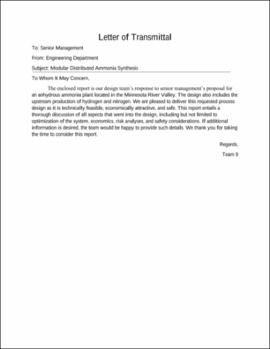| dc.contributor.author | Barber, Rylee | |
| dc.date.accessioned | 2021-03-25T18:52:15Z | |
| dc.date.available | 2021-03-25T18:52:15Z | |
| dc.date.issued | 2020-05-04 | |
| dc.identifier | oksd_barber_HT_2020 | |
| dc.identifier.uri | https://hdl.handle.net/11244/329069 | |
| dc.description.abstract | The preliminary design of an anhydrous ammonia plant was performed. In the United States, the Corn Belt is the largest consumer of anhydrous ammonia fertilizer, yet the Corn Belt obtains most of its fertilizer from the Gulf Coast. The transportation of ammonia fertilizer from the Gulf Coast to the Corn Belt is both costly and hazardous. To mitigate the additional safety and cost burdens associated with transportation of anhydrous ammonia, it is the objective of this project to produce the preliminary design of a plant located in the Minnesota River Valley. The project memo states this location to be especially suited for ammonia production due to its high demand in agricultural use within this region of the United States. | |
| dc.description.abstract | The plant is designed to produce 50 metric tons per day of anhydrous ammonia with a product purity of 99.5% by mass. The reactants utilized to produce anhydrous ammonia can be expensive and hazardous to transport, so it is the objective of this preliminary design to also design onsite production of both hydrogen and nitrogen. The desired purity is 99.9% by mole for both hydrogen and nitrogen. | |
| dc.description.abstract | The design selected to meet these requirements includes a pressure swing adsorption system for nitrogen production, which includes two adsorption towers, three double pipe heat exchangers, and three reciprocating compressors. The steam methane reforming for hydrogen production includes: one packed bed reactor, one membrane reactor, two shell and tube heat exchangers, one reciprocating compressor, one fired heater and two adsorption towers. The Haber-Bosch process was utilized for ammonia production, and includes one packed bed reactor, two shell and tube heat exchangers, three reciprocating compressors, one flash drum, one air cooled heat exchanger, and three storage tanks. Aspen HYSYS was utilized to simulate the process and evaluate methods for optimization. | |
| dc.description.abstract | A safety analysis was performed by examining mistakes that have occurred over the last 50 years in ammonia production that have led to safety issues. By discovering what could go wrong and what has gone wrong in the past, accommodations were made to produce an inherently safer design. Loss of containment was the biggest concern associated with the project resulting in focus throughout the process of mitigating this risk through inherent safety. | |
| dc.description.abstract | An economic analysis has been completed on the design with an expected project life of 20 years. The economic analysis yielded the net present value to be $15,000,000 in 2020 US dollars, and the DCFROR to be 13%. This displays the economic feasibility of the project as the minimum rate of return is 8%. The payback period was found to be approximately 8.3 years, and the breakeven product price was found to be $460. The design team has determined from this analysis that the project is both technically and economically feasible. | |
| dc.description.abstract | A sensitivity analysis was performed to determine the risk associated with the project. The impact of variation of the capital investment, raw material cost, operating cost, and revenue on the net present value and DCFROR were analyzed. Each variable was analyzed at a ±10%, ±20%, and ±30% variation. The variation of revenue had the greatest impact on the project. Through this analysis the team has deemed the risks associated with the project low. This supports the recommendation to move forward to the detailed design phase of the project. | |
| dc.format | application/pdf | |
| dc.language | en_US | |
| dc.rights | Copyright is held by the author who has granted the Oklahoma State University Library the non-exclusive right to share this material in its institutional repository. Contact Digital Library Services at lib-dls@okstate.edu or 405-744-9161 for the permission policy on the use, reproduction or distribution of this material. | |
| dc.title | AIChE National Student Design Competition: Modular distributed ammonia synthesis, Group 9 | |
| osu.filename | oksd_barber_HT_2020.pdf | |
| osu.accesstype | Open Access | |
| dc.type.genre | Honors Thesis | |
| dc.type.material | Text | |
| thesis.degree.discipline | Chemical Engineering | |
| thesis.degree.grantor | Oklahoma State University | |
